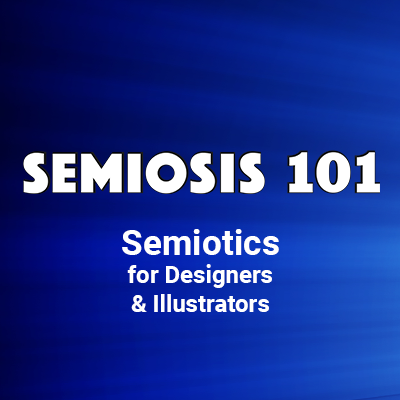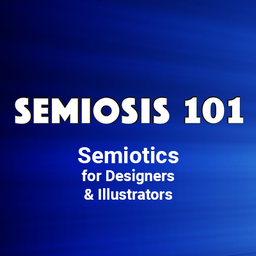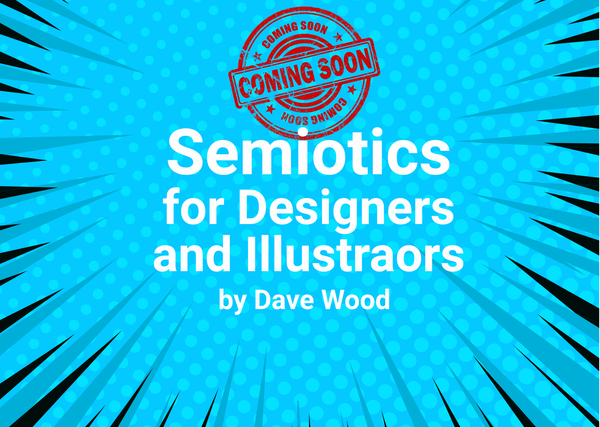Free Semiosis 101 Transcript 4.9:

How Do CREATIVES USE AUDIENCE Imagination TO CONVEY Meaning?
Hello readers.
In this free transcript for the episode 4.9 published on Semiosis 101 on Weds 20th August 2025, we focus on how familiar visual elements (semiotic signs to you and me) can be semiotically hacked to trigger audience imagination. With familiar qualities offering possible deeper meaning, audience imagination then moves any meaning-bearing *IT* from a dormant perception state, to different levels of interpreted meaning. One moment *IT* is meaningless, then instantaneously *IT* is meaning something more. In this design or illustration conundrum, *IT* is in plain sight to your audience as a visual element …and perceptually dormant until imagined as meaning-bearing…
Watch the free episode on YouTube for the full impact…
…and here is the episode’s transcript.</I>
How Do CREATIVES USE AUDIENCE Imagination TO CONVEY Meaning?
We are building the case for how your audience can influence your visual communication to them. We have explored how their lifeworlds can offer you clues to what visual qualities your audience will perceive as familiar. During your ideation, these initial familiar things can become your semiotic allies, as they are weak meaning-bearing semiotic signs. If the familiar can be imagined, we have semiotically begun…
In this 9th episode of Semiosis 101’s season four, we focus on how familiar visual elements (semiotic signs to you and me) can be semiotically hacked to trigger audience imagination. With familiar qualities offering possible deeper meaning, audience imagination then moves any meaning-bearing *IT* from a dormant perception state, to different levels of interpreted meaning.
One moment *IT* is meaningless, then instantaneously *IT* is meaning something more. *IT* after being perceived, whatever *IT* is, begins to mediate its deeper meaning to the target audience. Semiotically, *IT* has an effect on the perceiving audience’s imagination. If the audience can imagine that *IT* has more than a denotative meaning, then semiotic sign-action has begun.
In this conundrum, *IT* is in plain sight to your audience as a visual element, and perceptually dormant until imagined as meaning-bearing.
When I say imagined as meaning-bearing, this is a pragmatic effect on the mind of the audience. Charles Sanders Peirce’s Semiosis is a pragmatic semiotic theory. Through this philosophical pragmatic lens, ideas are perceived as social, situational and adaptive. Klaus Krippendorff, in his design book A Semantic Turn, whether he intended to or not, frames perception in pragmatic terms. He states that, “people cannot help but perceive their world through the vocabularies” they use. Let us look at this in more depth, but use “imagine” rather than “perceive.”
In previous episodes I have been discussing the importance to you creatives of your target audience’s lived experiences (lifeworlds). It is from these experiences that the audience makes new interpretations when encountering new visual stimuli. They will use words they already know to understand new things. The audience will think of these new things in terms they already understand. This previous understanding is socio-culturally situated. It is formed from knowledge the audience has previously learnt and experienced.
They interpret what is newly visually presented based on what they already understand. This is why I use the phenomenological term lifeworld for this lived experience. Semiosis, as a pragmatic semiotic theory is an applied process of moving the audience to new understanding from previous understanding. Semiotic sign-action facilitates the audience to imagine possible meaning-bearing from what is visualised.
Your target audience are all individuals, with individual experiences. Collectively, they will share some lived experiences within specific contexts - a lifeworld. Lifeworlds provide insights to how to successfully visually communicate to them. You only need to be concerned with this collective and contextual lifeworld.
We seldom design or illustrate for individuals, so let us focus our attention on semiotically “hacking” a lifeworld. What can your intended audience collectively imagine from your visual language? Why would we want to semiotically “hack” imagination? Remember, pragmatically, ideas are socially situated and adaptable. This means that by understanding what the target audience’s socially-situated expectations are, you can gain insights to what they can imagine (INTERPRETATION), to frame your visual language around (REPRESENTATION). To visually communicate the intended messages your client needs (CONCEPT), your understanding of your target audience’s lifeworlds can avoid miscommunication. After all, Science Fiction relies on what is currently understood in the present to imagine possible futures.
I have just reversed the semiotic determination flow. INTERPRETATION depends on REPRESENTATION. REPRESENTATION conveys the CONCEPT. In this way I centre your audience. Our use of visual language has to begin by taking the target audience to new understanding from what they are possibly already familiar with. This is why understanding lifeworlds is crucial to your creative ideation. That is why the weakest semiotic sign is possible, familiar and instant.
The perceptual switch from semiotically dormant to meaning-bearing begins with instant imagination. The audience can imagine other possible meanings from what the see, beyond the denotative. Semiotic sign-action is triggered by the manipulation of a socially-situated familiarity the audience can Immediately understand. Let me give a quick example.
We see a visual of an apple with a bite out of it. In one socially situated context this apple representation could interpret an intended concept of a tech brand. represented in a different way a fairy tale trope. The concept of a tech company is semiotically represented by an apple with a bite out of it, using specific on-brand visual language. The audience in this socially-situated context interprets “tech company.”
The concept of poisoning of a fairy tale princess by a wicked step-mother, uses a different form of visual language elements in semiotically representing apple. This audience, in this socially-situated context, interprets “a fairy tale.”
In one situated context, the apple is imagined as a tech company, and in the other situated context the apple is imagined as a device to get rid of a rival by poisoning. Ultimately, it is just a representation using semiotic qualities that forms a familiar “apple” shape. Both apple representations still have to be experienced and learnt that one is a brand, and one is poison. The audience’s imagination is utilised to get them to interpret the intended concept that the representation intends.
Both examples begin from the Hypothesis that the target audience has experience of a particular fruit. Without this grounding, it would not matter whether the apple was so aesthetically beautifully drawn. If the audience had never had experience of an existent thing as an apple, they would find it difficult interpreting apple from what they see.The closest that audience could interpret may only be fruit. Not so damaging for a fairy tale, but devastating for a tech brand!
If you want to read more about this then check out the Semiosis 101 Semiotic Resource on semiosis101.online. Link is below in the description.
Therefore, the visual language you craft to visually communicate your concept needs careful consideration.
At the beginning of this episode I used the catch-all phrase *IT* for whatever we design or illustrate. *IT* could easily mean the whole illustration or design, are parts with *IT*. You just substitute whatever you want for *IT*.
I already have. I have used apple instead of *IT*. We have seen that apple could be used to connote many different concepts. The only differences being the target audience and what is intended to be visually communicated. In semiotic terms, the concept to be interpreted from its representation. The visual language needed to imagine a brand will be different to a fairy tale’s needs. It is more than personal taste at work here in selecting the appropriate visual language for an apple.
The audience needs to be factored in. How will their imagination help? A child will need different visual language than adults needing to buy tech. But the visual language for theology may have crossovers with fairy tale representations of an apple. The visual language to represent a city will need to be different again. If you are instantly successful, the familiar shape of an apple can possibly be interpreted from this representation. It is at the next mediated semiotic power level that the audience is happy that an existent thing called an apple is the correct interpretation, but now this apple now suggests some other meaning than just fruit.
To be technical here, once an audience has interpreted apple as meaning more than apple, then their perceptual awareness has moved from a state of Firstness to Secondness. Once in this state, the audience’s attention is retained. The state of Firstness is triggered as soon as perception of meaning begins. Mediation to the intended encoded meaning happens after imagination is triggered. With audience imagination in a perceptual state of Secondness, the audience can be semiotically suggestible to deeper meanings. Full interpretation of the representation of the concept is only achievable if the audience can reach a state of Thirdness and resolve THIS means THAT now.
Meaning emerges first from the Imagination-of-the-Beholder!
We will focus in the next Semiosis 101 episode on resolving this mediated release of deeper meaning through our visual language, semiotic decisions. Remember and subscribe to be notified when this episode is published. Or become a Semiosis 101 Producer on Patreon and watch all future episodes months ahead of YouTube …plus other exclusive Patreon content and gifts.
Hint… hint…
Semiosis 101 Semiotic Design Resources is a reader-supported publication. To receive exclusive posts and support my work, consider becoming a free or paid subscriber. Paid subscribers get name checked on all future Semiosis 101 YouTube episodes.
===Semiosis 101 Patreon Producer==============
Become a Semiosis 101 Patreon Producer and get a named producer credit on future video episodes, plus watch all new episodes months ahead of YouTube.
===Semiosis 101 Patreon Exclusives==============
Watch longer Patreon-exclusive Semiosis 101 episodes on applying Semiosis into design and illustration…
PATEXC001 How does semiotics work in illustration?





